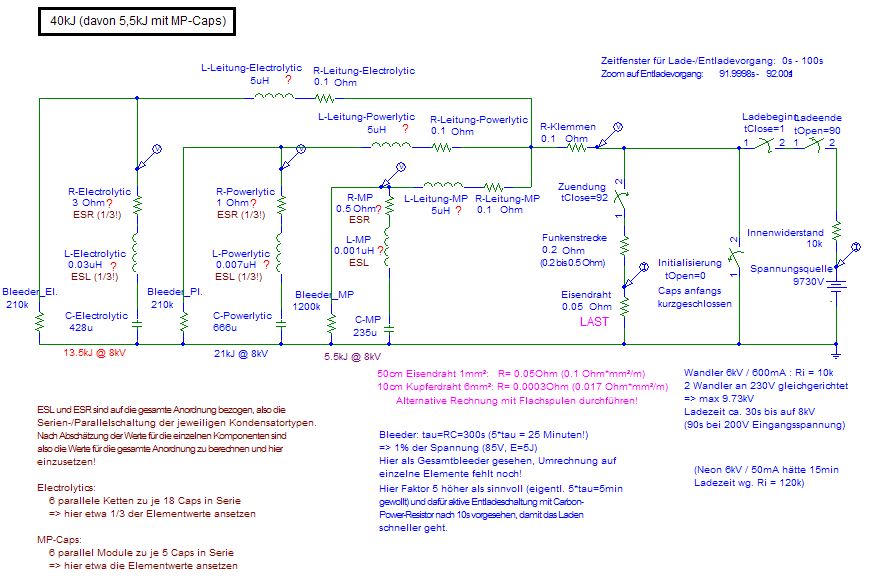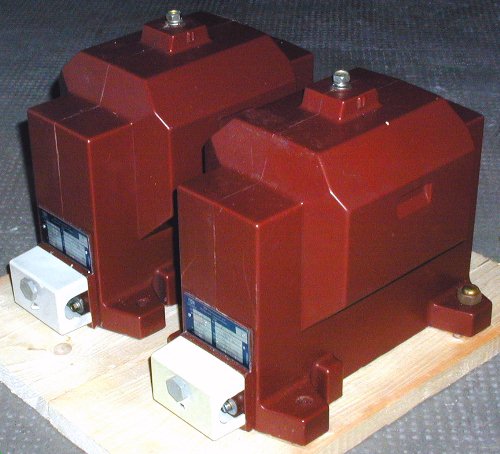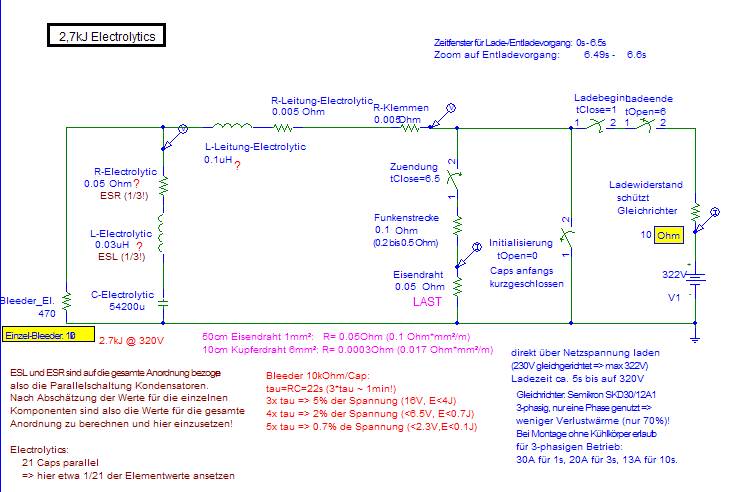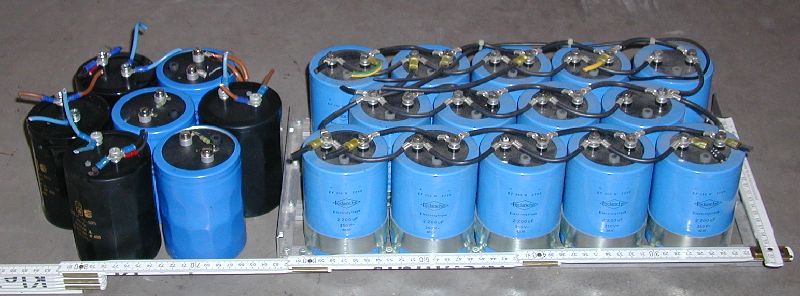Exploding wires, can crushers, coin shrinkers, ball lightning
High energy page
![]()
Exploding wires, can crushers, coin shrinkers, ball lightning
WARNING: big caps (>50J) are absolutely
deadly!
Defibrillators have approx. 500J, we are dealing
with energies an order of two magnitudes higher (up to 50kJ)
here!
50kJ equals dropping a VW Golf (a german car with 1400kg) from 3.5m, better
not to stand under the weight!
|
||||||||
The Bank of Electrolytics (used only for exploding
wires and creating of "ball lightning"):
The image shows 3/4 of my caps still in
storage:
I'll use 28pc. of 10.000µF@250VDC, 28 pc. of 6.000µF@350VDC (long),
28pc. of 6.000µF@350VDC (short), 4pc. 5600µF@450VDC (short) and
4pc. 3900µF@400VDC (short). Using different Caps in series is not ideal,
but hopefully they will survive. I'll try to use them only in soft applications
like creating ball lightning and thry to avoid voltage
reversaln with the help of a big thyratron switched as a bypass diode.
The following two half-modules rated 10kV will be abused with 8kV (80% voltage).
I'll build four such half-modules:

Each full module will give me 6.7kJ at 8kV for a total of 13.5kJ electrolytic
power (total of 420µF@8kV).
As you can see, each module consists of two parts. Therefore I can use them
also as 1680µF@4kV (diode instead of thyratron).
The clip collars for the caps are mixed plastic and metal. The ones in the 4 corners of each box have to be plastic because the castors (rollers) will be screwed against the bottom with metal screws (I always see the floor as a conductor)...
At the moment I'm building the boxes (right size is important for storage
in the basement shelf!) from black MDF I got mid of November 2006 (thanks
again Daniel!).
This proess is delayed at the moment since I have to move part of my equipment
into an other cellar some 100m away.
![]()
Charging circuit:
6kV neon sign transformer (rated 80mA, will be boosted to approx. 200mA) with bridge rectifier (2 stacked 6kV@100mA - diodes each leg) for 8kV charging voltage, small variac to adjust voltage.
Releasing the energy:
A) Firing the bank of MP-caps will be done via my EG&G GP-41B-25 triggered spark gap. It usually should be operated between 12kV and 36kV, can cope with a charge of up to 0.5 coulomb and peak currents of up to 50kA. Triggering will be achieved by a simple ignition coil and light dimmer circuit via two 0.5nF/30kV capacitors like Ross Overstreet suggested on his website.
B) Should the EG&G gap ever die, I can build a robust gap out of two 60mm spheres (approx 7.5mm for 25kV according to the table in he HV-book of Jim Lux). The gap setting can be tested (VOM with HV-probe) with a small capacitance and big charging resistor.
C) NEW: On the teslamania-website of Bert
Hickman I found a nice solution of a solenoid spark gap with moving contact.
The contacts are brought close together so that the voltage is sufficient
for breakdown. But they do not make physical contact. This way, no welding
together can occure.
I intend to use such a gap here to cope with the smaller voltage and higher
energy I have now available (not so good for the EG&G gap). Perhaps I'll
use some graphite electrodes on a pneumatic cylinder driven from a
small compressor. Setup will be: compressor, switching pressure gauge (to
switch compressor off via a contactor when a certain pressure is reached),
pressure regulator (with integrated particle filter), 5/2-way valve, pneumatic
cylinder (10bar). The valve will be pneumatically activated by a 3/2-way
valve which itself is activated pnematically when the operator turns
a pneumatic switch. This pneumatic switch is actually a manually
operated 3-way-valve. It assures that the tubing vented normally so
that no accidential activation can occure. This way, the operator only has
contact to two insulating tubings with a pneumatic switch at the end, no
electric conductive wires involved.
D) Another idea is to use a pressure dependent switch (low pressure) to activate the 3/2-way valve mentioned above. In this case, the operator only has contact to an insulating tubing with a rubber bulb at the end. One squeeze and the switch will be activated.
E) I'll use perhaps a MOT (microwave oven transformer) with rectifier
(tbd., will include charging resistor for limiting
the initial current through the rectifier diodes) and variac
(to set the max. voltage) to achieve the
8000V.![]()
Varying the charging voltage, I'll perform the experiments with the following energy levels
| E [kJ] | U [kV] | C [µF] | E [%] |
| 1.4 | 2.5 | 420 | 10 |
| 2.0 | 3.1 | 420 | 15 |
| 2.9 | 3.7 | 420 | 21 |
| 4.3 | 4.5 | 420 | 31 |
| 6.3 | 5.5 | 420 | 47 |
| 9.2 | 6.6 | 420 | 68 |
| 13.5 | 8 | 420 | 100 |
These steps follow a logarithmic scale like the E6-series of resistors, with a factor of 1.47 between each step of energy.
Planned arrangement of all our (Daniel, Toni, me) modules for the real
big bang:
That sums up for 1.36mF@ 8kV which represents 43.6kJ electrolytic power. (8.6kV will result in 50kJ, 8.9kV will result in 54kJ - that is 3 M&M's Choko).
(I still have to update the next image, the values of caps are wrong)

The whole thing will eventually be charged by my 6kV/100V-voltage
converters:

or 3 MOTs connected in series (not so heavy as the two monsters above).
Wenn die Bleeder zu niederohmig sind, erreichst Du nicht die volle Ladespannung an den Caps.
Wenn die Bleeder zu hochohmig sind, bringen sie nix mehr an Sicherheit (tau=R*C wird zu lang). Ich schlage deshalb vor, nur recht hochohmige Bleeder zu nehmen, so daß sie nur ein Wiederaufladen der Caps im Keller verhindern. Sowas in der Art von 1W pro kJ an 8kV ergibt dann 1.5MOhm an 8kV für ein 1kJ-Modul.
Am Beispiel meiner Aerovox-Caps: eine 4'er-Kette von Caps mit 2kJ Gesamtenergie an 8kV benötigen dann z.B. 700kOhm gesamt bzw. 180kOhm pro Cap. Die Zeitkonstante wäre hier: tau = R * C = 1.5MOhm * 1.34mF = 34 Minuten. Nach 5*tau = 2.8h wäre die Ladespannung auf 0.7% abgesunken, das entspricht 56V, was bei der Kapazität von 1340µF noch 2.1J entspricht. Da zuckt man immer noch ordentlich... (entspricht 100nF bei 6.5kV). Würde man die 10-fache Leistung in den Bleedern verbraten (430W in der gesamten Anordnung dann zuzüglich Meßgerät) wäre 5*tau immer noch 17 Minuten, bringt also nicht wirklich viel außer daß es den Ladevorgang ungünstig beeinflusst. Zur Not muss man halt > >2.8h warten wenn die Sicherheitsschnellentladung versagt. Die Bleeder müssen parallel zur Glimmlampe liegen, da die Glimmlampe ja immer nur ab ca. 65V leitet!
Aktive Entladung (immer auch nach dem Schuß) deshalb dann mittels Sicherheitsschnellentladung. Dafür habe ich Carbon(?)widerstände. So groß wie die grünen glasierten 200(300?)W-Widerstände aber eben im gesamten Material (Keramik + Karbon?) leitfähig. Hab sie noch nicht durchgemessen, aber da sollte was passendes dabei sein. Die 200W-Widerstände aus Vollmaterial reichen angeblich für 5kJ (siehe Text auf dieser website hierzu). Sollte dann aber grob überdimensioniert werden, da es ein essentielles Sicherheitselement ist. Für uns (43kJ) sollten wir bei Faktor 2 an Sicherheit also ca. 17 solcher Stäbe nehmen. Mal sehen was ich alles davon im Keller habe. Zeitkonstante etwa 0.1-1s stelle ich mir vor, also insgesamt 75-750 Ohm.
Ein Kurzschließen der Caps wäre auch zusätzlich sinnvoll vor Berührung der Klemmen. Hierfür manuell(!) per Zugseil betätigter Schalter um unabhängig von einer Serienschaltung von >>10 Zeitrelais zu sein ;-)
Messung des Stromes: Daniels Shunt mit Max seiner Faseroptik an Max seinem Speicheroszi
![]()
Steuerung:
sicheres Einschalten (Verriegelung: bei Stromzufuhr muß
manueller Kurzschlußbügel in Kurzschlußposition sein und
mechanischen Taster damit betätigen, siehe Daniel)
Signalleuchte Dauer-grün plus akkugestützte weitere grüne
Leuchte
manuelles Entfernen des Kurzschlußbügels
Signalleuchte Dauer-gelb bzw. eine akkugestützte weitere grüne
Leuchte geht aus
automatisches Entfernen des automatischen Kurzschlußes (Schütz)
Start der Aufladung durch Knopfdruck
Signalleuchte gelb getaktet (2Hz)
Zeitsteuerung (für feste Anordnung von xfmr und Caps) bzw.Ladespannungsüberwachung (variable Anordnung, ist aber fehleranfällig und dadurch gefährlicher). Am besten die maximal mögliche Ladespannung über Variac intern begrenzen!
Abschaltung der Spannungsquelle bei Erreichen der
Ladespannung, akkustische und optische Signalgabe (1s),
5s vor Start des Zeitfensters für manuelle Zündung
Start des Zeitfensters für manuelle Zündung
(max.30s)
Signalleuchte Dauer-rot
manuelle pneumatische Zündauslösung innerhalb Zeitfenster möglich
gezielte Schnellentladung (über Lastwiderstand)
der Restenergie 10s nach bzw. der Gesamtenergie bei fehlgeschlagener
Zündauslösung
(PROBLEM: um die Restspannung zuverlässig abzulesen muß Zeitfenster
lang genug sein, für sichere Entladung muß es kurz genug
sein!!!)
automatisches hartes Kurzschließen (Schütz)
5s nach Beginn der Schnellentladung
Signalleuchte Dauer-gelb
vor Berühren ist manuelles Kurzschließen
erforderlich um Signal (batteriegestützte Hupe, Blitzlicht) zu deaktivieren
(Schaltkontakt an mechanischem Hebelarm)
bzw. eine akkugestützte weitere grüne Leuchte geht wieder an
Signalleuchte grün,
bereit für erneute Aufladung
------------------------------------------------------------
weitere Sicherheitsfeatures:
allpolige Trennung der Anschlußklemmen (3Ph-Schütz mit 2Ph an einem Kontakt und eine Ph am anderen Kontakt bzw. besser 2 Schütze wovon nur eines zum Schalten unter Last dient (d.h. das andere schließt bereits vorher, z.B. bei Ertönen der Hupe 5s vor Auslösung)
Glimmlampen an den Caps (sieht man nicht in der gedeckelten Box...) => große Glimmlampe außen anbringen
Bleeder
analoges Voltmeter mit automatischer Bereichsumschaltung (Ladespannung 10kV / Restspannung 1kV bzw. 100V) außen an der Box
Kapazitätsmessung pro Halbmodul-Kiste (LCR-Meter geht evtl. nicht bis in diesen Bereich?)
------------------------------------------------------------
Weitere Features:
Digitales Voltmeter über Tastkopf (könnte wozu benutzt werden???)
Messung des Spannungs- und Stromverlaufes (Speicheroszi nötig!)
Filmchen mittels OlyC2020: 320x240@15fps (1/30s) bzw. 160x120@60fps (1/120s???) also 4x soviel Bildern (ca. 25 Einzelbilder dann vom BL-Ereignis, aber eben nur stark reduzierte Auflösung!)
Filmchen mittels K800i: Auflösung? fps? Belichtungszeit pro Frame?
Glimmlampe pro Cap => Anzeige von Spannung bzw. Restspannung
I got some advice from Bert Hickman:
Electrolytic caps do not support voltage reversals. In fact the dielectric will break down under any significant voltage reversal, helping to damp any ringing. Most pulsed applications with inductive loads (such as pulsed magnetizers) use a high current diode across the capacitor bank to handle reverse current during ringing.
If you're only going to explode wires, you probably
won't need a diode. However, if you ever plan on driving a coil (ring or
disk launcher, magnetizer, or coil gun) you'll need a diode. The current
rating depends on the inductance and resistance of your work coil and the
ESR of your capacitor bank. You may find the following tool (for coil gun
design) handy in getting a feel for the design parameters:
http://mgc314.home.comcast.net/ckt_sim/ckt_sim_main.htm
You'll want to use a power diode with a PIV that's at least the same or greater than the maximum voltage applied to the capacitor bank, and who's peak surge current rating (typically for 1/2 cycle of mains current or 17-20 milliseconds) is about the same magnitude as the peak reverse current - use the simulator above (or PSPICE) to estimate the peak reverse current.
I have no idea about the ESL and ESR of the caps up to now.
Another uncertain value is the resistance of the arc in the gap. For TC's, a value in the range of 2-3 Ohms is assumed. I'm sure that for the currents involved here, the resistance is much smaller (current is approx. two orders of magnitude higher, therefore the resistance should be at least an order of magnitude smaller).
Small signal measurements (with the use of a shunt resistor of small value compared to total resistance of circuit) will give the total resistance of the circuit (from max. current) and the total inductance can be determined afterwards from the decay (current over time). Both measurement require a storage scope for analysing single pulses. I don't have one, so I will use an f-gen to check the resonance frequency of the arrangement first. Knowing C this will also lead to the knowledge of L. Still don't know how to measure the gap resistance and the ESR of the caps....
Bert Hickman achieves some 10kA, with somewhere around 25kV and approx. 24uF (8.5kJ). So the total resistance (ESR of the caps plus arc resistance in the gap) according to the MGC-simulator (link above) seems to be somewhere in the range of 0.1-0.3 Ohms for his arrangement. Therefore I think I can assume somewhere between 0.1-0.2 Ohms for the arc resistance for my arrangement. According to the book "Rechnungsgrößen für Hochspannungsanlagen" (Heinrich Langrehr, AEG-Telefunken-Handbücher Band 9, 1969, page 111), the resistance of an arc shorter than 1m of length is in the range of 0.1-0.2 Ohms if the current is well above 500A (below 500A, the resistance is about 5 times this value). The arc resistance of my EG&G triggered spark gap is listed to be in the range of tens of milliohms. Of course, the arc channel has to have a certain diameter to achieve those low values of resistances. A free arc with currents above 500A will have a current density of approx. 500A/cm2 according to the book "Hochspannungstechnik" (Sirotinski, Band 1, Teil 1, VEB Verlag Technik Berlin, 1955, page 280). For those high current arcs, the diameter (in cm) of the arc channel is 0.057*sqr(I) according to Sirotinski. Assuming a current of 30kA, the electrode diameter of the gap should be in the order of four inches! Since the distance of the electrodes is much smaller (only some mm for 4kV assuming nearly parallel planes with smooth edges), the diameter can be smaller, to. But it should be not to small for achieving a low resistance in the channel.
Suitable values for the shunt resistor will be: 1mOhm for real discharges (50kA := 50V) and 100mOhm for small signal measurements (50 := 5V).
Releasing the energy:
The bank of electrolytics will be fired with the help of one of the following mechanisms:
1) Directly with a big contactor. It was originally for 3 phases each 660V~ which equals 3x660Vx1.41=2800VDC (400A?). It was made to industral standards and therefore could cope with a good overload ;-) Daniel tested them successful (two contacts wired in series) with 12KVeff without arc-over. Many thanks again, Daniel, for giving me two of those big contactors! Daniel used a clever circuit with timing relais. The big contactor was switched by another one which also switched the discharge resistors in after the big bang. Therefore the caps will be discharged even if the contacts of the big contactor will weld together one time.
2) With a vacuum gap. Changing the pressure results in a different breakdown voltage. No moving contacts, nothing can weld together.
3) Moving contacts (spring loaded, hold with electromagnet before firing), only proximity (no direct contact). 2kV will be ~2mm, 4kV will be ~4mm. Electrode material will be graphite, copper, brass or steel. Ich dachte Anfangs daran, die bewegliche Elektrode mit einer Feder vorzuspannen und mittels Elektromagnet zu halten. War mir aber dann zu unsicher. Ich muss mir das mal durchrechnen um zu sehen ob es überhaupt was bringen würde im Vergleich zur elektrischen Dauer der Entladung.
4) Wie wärs mit ner Druckluft-Funkenstrecke? Einfach druckfest aufbauen (dickes Lexan als Isolator, Rest alu) und die Elektroden so einstellen, dass es bei normalem Druck zündet, bei erträglich hohem Druck (5bar?) aber zuverlässig isoliert. Dann mit Druckluft aufpumpen bis 8Bar, Caps laden, Druck ablassen.
Safety circuits:
Die Hochleistungstypen 6000uF/350V sind mit 20nH angegeben.
The small bank of Electrolytics:
(will be used for getting some experience in exploding wires and other
things)
Additionally, I have 17 caps 2200uF(3 are 385V, 14 are 350V and are already wired in parallel in a nice rack) plus 3 caps 5600uF each (have to update that list, values might be no longer valid). When connecting all of them in parallel for 54200uF, I can charge them with just the rectified mains (230V x 1,4 = 310V) which results in 2.6kJ of stored energy. (16.8 Coulombs of charge) Hopefully, this will be enough for perfoming small demonstrations and getting some experience in exploding wires.

charging:

discharging:

Caps:

![]()
